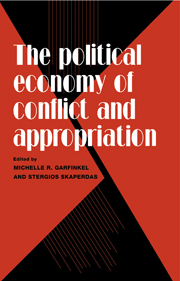Book contents
- Frontmatter
- Contents
- List of contributors
- Acknowledgments
- 1 Introduction: Conflict and appropriation as economic activities
- 2 Anarchy and its breakdown
- 3 Towards a model of territorial expansion and the limits of empire
- 4 Predation and production
- 5 Competitive trade with conflict
- 6 Increasing returns to politics in developing countries with endogenous protection in a fixed-factor model
- 7 Demosclerosis, or special interests “R” us: An information rationale for political gridlock
- 8 Deforestation, investment, and political stability
- 9 Violence and the assignment of property rights on two Brazilian frontiers
- Index
4 - Predation and production
Published online by Cambridge University Press: 30 December 2009
- Frontmatter
- Contents
- List of contributors
- Acknowledgments
- 1 Introduction: Conflict and appropriation as economic activities
- 2 Anarchy and its breakdown
- 3 Towards a model of territorial expansion and the limits of empire
- 4 Predation and production
- 5 Competitive trade with conflict
- 6 Increasing returns to politics in developing countries with endogenous protection in a fixed-factor model
- 7 Demosclerosis, or special interests “R” us: An information rationale for political gridlock
- 8 Deforestation, investment, and political stability
- 9 Violence and the assignment of property rights on two Brazilian frontiers
- Index
Summary
Although most economic agents allocate most of their resources to productive activities, sometimes individuals and groups live mainly or solely by appropriating from others. For example, at some stages of their histories the Vikings and the Mongols seem to have been pure predators. Other examples include individuals who specialize in being thieves and robbers. Under what conditions would an individual or a group choose to produce nothing and devote itself to preying on others?
Adam Smith (1776, Book V, Chapter 1, Part I) observed the relation between the relative wealth of nations and appropriative interactions.
That wealth … which always follows the improvements of agriculture and manufacture … provokes the invasion of all their neighbors. An industrious, and upon that account a wealthy nation, is of all nations the most likely to be attacked …
The wealth of a richer agent gives a poor agent an incentive to prey on the richer agent and, perhaps, even to be a pure predator. Jack Hirshleifer (1991) provides an interesting example in which, if the relative endowment of an agent is sufficiently small, then that agent allocates all its resources to predatory activities.
This paper develops a general equilibrium model of appropriative interaction between two agents, a potential predator and the prey. The prey allocates its resources to the production of consumables and to defensive fortifications that serve to protect its property. The potential predator allocates its resources either to the production of consumables, or to offensive weapons that the predator uses to appropriate the prey's property, or to both.
- Type
- Chapter
- Information
- The Political Economy of Conflict and Appropriation , pp. 57 - 72Publisher: Cambridge University PressPrint publication year: 1996
- 23
- Cited by



